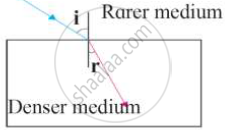Advertisements
Advertisements
Question
When rays of light are incident on a glass slab then the incident ray and emergent ray are _________ each other.
- perpendicular
- parallel
- opposite
- concurrent
Solution
(b) Parallel
When rays of light are incident on a glass slab, the incident and the emergent rays are parallel to each other. However, the emergent ray is displaced from the actual line of the incident ray. This is called lateral shift.
APPEARS IN
RELATED QUESTIONS
Four students P, Q, R and S traced the path of a ray of light passing through a glass slab for an angle of incidence 40° and measured the angle of refraction. The values as measured them were 18°; 22°; 25° and 30° respectively. The student who has performed the experiment methodically is
(A) P
(B) Q
(C) R
(D) S
Write a relationship between the angle of incidence and angle of refractions for a given pair of media
A ray of light passes from water to air. How does the speed of light change?
How must light travel out of a substance if it is not going to be refracted?
Draw diagrams to show the refraction of light from
- air to glass, and
- glass to air. In each diagram, label the incident ray, refracted ray, the angle of incidence
- and the angle of refraction (r).
A monochromatic ray of light passes from air to glass. The wavelength of light in air is λ, the speed of light in air is c and in glass is V. If the absolute refractive index of glass is 1.5, write down
- the relationship between c and V,
- the wavelength of light in glass.
The highest refractive index is of ______.
With the help of diagram of the principal section of a prism, indicate its refracting surfaces, refracting edge and base.
How does the angle of minimum deviation produces by a prism change with increase in :
the wavelength of incident light
A ray of light is passing from a transparent medium 1 to another transparent medium 2 (i) Speed up (ii) slows down. In each case, state whether the refractive index of medium 2 is equal to, less than or greater than the refractive index of medium 1.
What do you understand by the statement the refractive index of glass is 1.5 for white light?
An object is viewed through a glass prism with its vertex pointing upwards. It appears to be displaced upward. Explain the reason.
A coin is places at the bottom of a beaker containing water (refractive index = 4/3) to a depth of 12 cm. By what height the coin appears to be raised when seen from vertically above?
The refractive index of air with respect to glass is expressed as `""_g μ_a=sin i /sin r`.
- Write down a similar expression for aμg in terms of the angles i and r.
- If angle r = 90°, what is the corresponding angle i called?
- What is the physical significance of the angle i in part (b)?
While performing the experiment on tracing the path of a ray of light through a rectangular glass slab, in which of the following experimental set-ups is a student likely to get best results? P1 and P2 are the positions of pins fixed by him.
(A) I
(B) II
(C) III
(D) IV
Observe the figure and write accurate conclusion regarding refraction of light.

What is the correct reason for blinking / flickering of stars? Explain it.
a) The blasts in the stars.
b) Absorption of star light by the atmosphere.
c) Motion of the stars.
d) Changing refractive index of gases in the atmosphere.
Which of the following has the highest refractive index:
In an experiment of finding the refractive index of glass, if blue light is replaced by the red light, how will the refractive index of glass change? Give reason in support of your answer.
The critical angle for glass-air interface is :
A total reflecting equilateral prism can be used to deviate a ray of light through:
Why does a fisherman aim at the tail of fish during spearfishing?
Why upper surface of water contained in a beaker and above eye level appears silvery?
Name one main factor on which the direction of bending of a ray of light depends.
State the relation between the refractive index μ and the velocity of light (vm) in that medium.
What do you understand by the deviation produced by a prism?
You are provided with a printed piece of paper. Using this paper how will you differentiate between a convex lens and a concave lens?
Draw a diagram to show the refraction of a monochromatic light ray through an equilateral prism. On the diagram, label the incident, refracted, and emergent rays. It also indicates the angle of deviation by the letter δ.
How will you verify the laws of refraction or how the refractive index of glass is determined in the laboratory?
The diagram shows the path of a ray of light through a rectangular glass block placed in a liquid of uniform density.

(a) Does the light speed up or slow down in the glass,
(b) Give the reason for your answer.
The diagram shows the path of a ray of light through a rectangular glass block placed in a liquid of uniform density.

What should be the rate of the speed of light through the liquid to the speed through the glass so that there is no refraction of light at the boundaries of the glass block when the system is illuminated by the light of one colour?
The velocity of light in diamond is 121000 kms-1. What is its refractive index?
